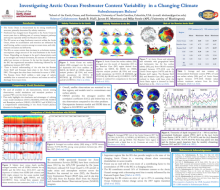Investigating Freshwater Content Variability in the Arctic Ocean in Changing Climate
Subrahmanyam (Subra)
Bulusu
University of South Carolina
Poster
Freshwater has changed more frequently in the Arctic Ocean in recent years due to differing rate of sources/transport pathways and exports especially within the Beaufort Gyre (BG). The BG serves as a large freshwater reservoir within the Arctic Ocean, where its accumulation and retention are influenced by wind forcing, surface currents among ice-ocean stress, and eddy-induced circulation and diffusivity. The BG, an ocean current that circulates in a clockwise motion, encompasses a large amount of the total freshwater in the Arctic Ocean. Depending on changes in the gyre’s characteristics such as its strength and vertical movement, the amount of freshwater added can increase or decrease. In the last few decades (years), the BG has experienced anomalous freshening followed by its stabilization between 2007-2008. There is limited understanding of the role that the Russian Arctic Shelf and Eurasian basin plays in the Arctic Ocean’s FWC. This region has often been overlooked in terms of FWC. The Russian Arctic Shelf exhibits a wide range of salinity variability due to seasonal sea ice advance and retreat as well as discharge from major rivers. The Russian Shelf contributes around 16% of freshwater content to the Arctic Ocean’s storage with a decreasing trend that is mainly influenced by the Kara and Laptev Seas. Neglecting the Russian Shelf creates an error of up to 25% in assessing Arctic Ocean freshwater volume change across the 2007 regime transition. Notably, the Russian Shelf experienced a significant decrease in freshwater content during 2007, when the BG coincidentally accumulated a large amount of fresh water, possibly owing to a change in ocean currents. This study uses all available in situ measurements, remote sensing observations, model simulations and reanalysis products to examine FWC and salinity in the Russian Arctic Shelf, Eurasian Basin, BG, and over the Arctic Ocean as a whole. This study highlights the drawbacks and advantages of utilizing ocean model simulations (ECCO, MIZMAS, HYCOM, NEMO) and Reanalysis products (ORAS5, GLORYS12 and SODA3) for a comprehensive understanding of the Arctic Ocean’s physical dynamics in changing climate.

bulusu-subra-polar-poster.pdf
(3.01 MB)
